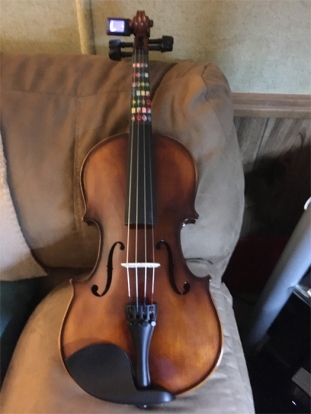Tuning a Violin
Posted on January 21, 2019

Once I had my fiddle all set up, the next thing I had to do was tune the instrument. Thankfully, my kit came with an electric tuner, which you attach to the scroll of the fiddle — apparently it needs to feel the vibration as well as hear the note? I dunno. But it works well enough, and I’m glad to have it.
While I’ve had experience tuning guitars in the past, violins are a bit different. They only have 4 strings, for one thing. And they also have these things called fine tuners on the tailpiece. Once again, I turned to the series of videos I was learning from to see how it was done. This one is a bit ponderous, because one has to “stretch the strings” at first, and requires several tunings.
It was at this point that I started to see the first minor flaw with my cheap violin. Tuning the E string is very difficult, and I often have to leave it slightly undertuned out of fear of snapping it. There’s a lot of pressure going on with the E string in particular, and though I have a second set of strings that came with the kit, I really didn’t want to start out breaking in a new instrument by losing a string immediately. Plus, I’m just scared of the whole concept of string snapping.
I also found that the main tuning peg for my E string doesn’t like to stick and hold well. I learned that I needed to try to apply some pressure inward to get it to catch. It did, but it still slips a lot. There’s something called peg drops I might need to invest in. Apparently slipping pegs are not uncommon.
Anyhow, once I got my fiddle in tune, I took the first official picture of it. You can see it here, with the tuner still attached!
It may be a VSO, but it’s not a bad looking little instrument. And at the time, I was just proud that I’d learned enough to set up the strings, place the bridge, and tune the instrument…. since this was the first time I’d really touched a violin of any sort.
You’ll notice that I also added a chart to the finger board – violins don’t have frets like a guitar, so you have to learn the positions. I’m really glad I picked this up because it’s starting to be really useful now that I’m learning individual notes in my practices.
You can find this guide on Amazon. Though there are others similar to it, this was the one I chose, and I’m happy with it. It was pretty easy to put on (granted, I did this before I put the bridge on and all). But even with a set-up violin, I doubt it would be any trouble to place.
Now, with an instrument set up and in tune, there’s still a few more things I needed to learn about before I could start: the bow and rosin.